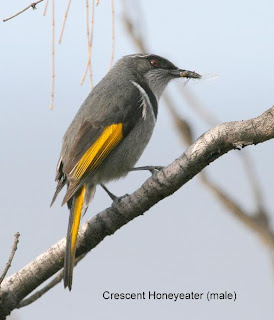 Out birding at Mortimer Bay recently, with a long time friend, and during the wide ranging discussions, I mentioned that I had an observation and question about Crescent Honeyeaters. Well we must have had some telepathic thought process going, as he started the answer without hearing my question! Perhaps I had broached the subject before, but it was in regard to Crescent Honeyeaters breeding, and apparently something that had been mooted during the first Bird Atlas in the early '80s.
Out birding at Mortimer Bay recently, with a long time friend, and during the wide ranging discussions, I mentioned that I had an observation and question about Crescent Honeyeaters. Well we must have had some telepathic thought process going, as he started the answer without hearing my question! Perhaps I had broached the subject before, but it was in regard to Crescent Honeyeaters breeding, and apparently something that had been mooted during the first Bird Atlas in the early '80s.On the Eastern Shore of the River Derwent, Crescents are visitors during the cooler months, and commonly seen at that time in gardens and the surrounding bushland. In the main they're abs
 ent here in the Summer months, except in a few isolated areas of wetter forest, such as parts of the Meehan Range. However, during last Spring, I had photographed a very juvenile male Crescent (lower left) on Rosny Hill in early September, certainly not a typical area for Crescents to breed. I also recall photographing an apparent pair of this species on Bellerive Bluff a few days earlier, at a spot that they were frequently returning to. Closer examination of those images showed that they were carrying bills full of flying insects, as in the shot of a male at top left. Why I didn't 'twig' that they could be breeding there, I'm not sure, but
ent here in the Summer months, except in a few isolated areas of wetter forest, such as parts of the Meehan Range. However, during last Spring, I had photographed a very juvenile male Crescent (lower left) on Rosny Hill in early September, certainly not a typical area for Crescents to breed. I also recall photographing an apparent pair of this species on Bellerive Bluff a few days earlier, at a spot that they were frequently returning to. Closer examination of those images showed that they were carrying bills full of flying insects, as in the shot of a male at top left. Why I didn't 'twig' that they could be breeding there, I'm not sure, but  I probably dismissed it as being outside their normal breeding range. One of the shots (at right) clearly shows a bird carrying a faecal sac-- an 'envelope' containing the faeces of a nestling--a clincher that the pair were breeding close by, possibly among the sheoaks clinging tenuously to the cliff face.
I probably dismissed it as being outside their normal breeding range. One of the shots (at right) clearly shows a bird carrying a faecal sac-- an 'envelope' containing the faeces of a nestling--a clincher that the pair were breeding close by, possibly among the sheoaks clinging tenuously to the cliff face.So it appears that a few of the local Crescent Honeyeaters breed here, before both parents and young move (separately) away into the 'normal' Summer quarters. The question then arises, do they subsequently breed in their normal range and is this a relatively new phenomena, or has it just been overlooked previously.
2 comments:
Nice photos. I was down at Pipe Clay Lagoon area today and saw many Crescent Honeyeaters. No Double-banded Plover though.
Thanks Russ,
The coastal heath around Pipeclay Lagoon usually holds good numbers of Crescent Honeyeaters at this time of year, together with Little Wattlebirds, New Holland Honeyeaters, and a smattering of Yellowthroats. Double-banded Plovers can be hard to find in the lagoon, and they're sometimes in the paddocks. If you want to see Doublebandeds, Lauderdale usually has 20 or so during the Winter. They're usually in the bay opposite the pub and shopping centre--they were there this morning as I drove past.
Post a Comment